Japan is a very popular destination to visit in spring due to its famous cherry blossom season. However, I think the fall colors in Japan are even more special.
The autumn season sees fewer crowds, and hotels tend to be cheaper, but most importantly, there are stunning fall colors at every corner.
Here are my 10 favorite places to see fall colors in Japan. Some of these spots are near Nagano. I called this prefecture home for a year. Nagano has some of the most tranquil nature attractions in the entire country.
Love Japan? Read my Ultimate Japan Bucket List: The Best Thing to Do in Every Prefecture

Hi. I am Noah Takes The World. I traveled solo to every prefecture in Japan, and now I want to help you do the same. Solo traveling is freeing, and it does not have to be expensive.
Subscribe to my monthly newsletter—stunning photos and stories to guide your solo trip
This post may have affiliate links. I receive a small percentage if you book a hostel or attraction through my recommended links. This is at no extra cost to you and helps me reach my goal of becoming a full-time digital nomad.
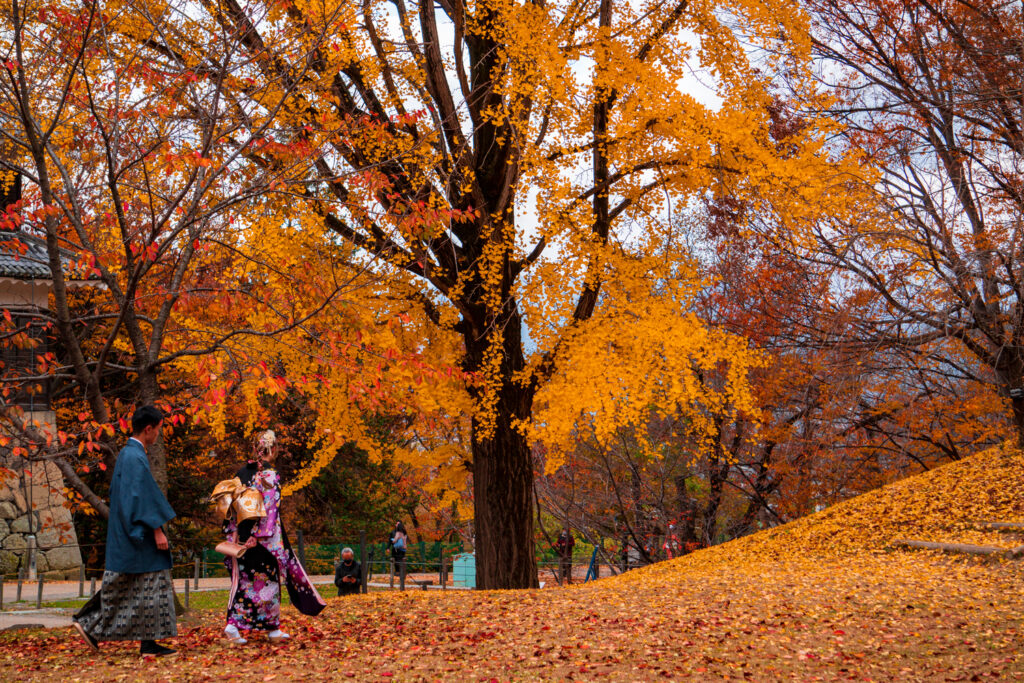
- 1. See Unforgettable Foliage on the Tateyama Kurobe Alpine Route
- 2. Take in an Iconic View at Lake Kawaguchi
- 3. Enjoy Falls Colors in Shiga Kogen, an Unspoiled Nature Park
- 4. Get Lost in Autumn’s Beauty in Togakushi
- 5. See Fall Colors Without Hiking at the Nagano Olympic Stadium
- 6. Take in an Epic Fall View at the Arato Castle Ruins
- 7. Photograph a Sea of Yellow at Ueda Castle
- 8. Enjoy Fall Colors in Karuizawa, an Upscale Resort Town
- 9. Take the Train From Tokyo to Okutama
- 10. Go to Daisetsuzan, Where Autumn Colors First Appear in Japan
1. See Unforgettable Foliage on the Tateyama Kurobe Alpine Route

I highly recommend this one if you can only visit one place on this list. Nothing will prepare you for the explosion of colors you will encounter on this 5-hour-long mountain route across the mesmerizing Northern Alps from Tateyama, Toyama, to Omachi, Nagano.
One highlight of taking this intricate series of trains, buses, cable cars, and ropeways is seeing Kurobe Dam, the tallest dam in the country. Walking across this roaring dam while it is framed by yellow and orange trees is incredible.
However, the views do not end there, which makes it one of the best places to see fall colors in Japan. Taking the ropeway to reach Murodo, the highest point along the route, is perhaps the most impressive part of the trip. Crossing a sea of fiery trees via a small gondola is a heavenly experience.
When to Go:
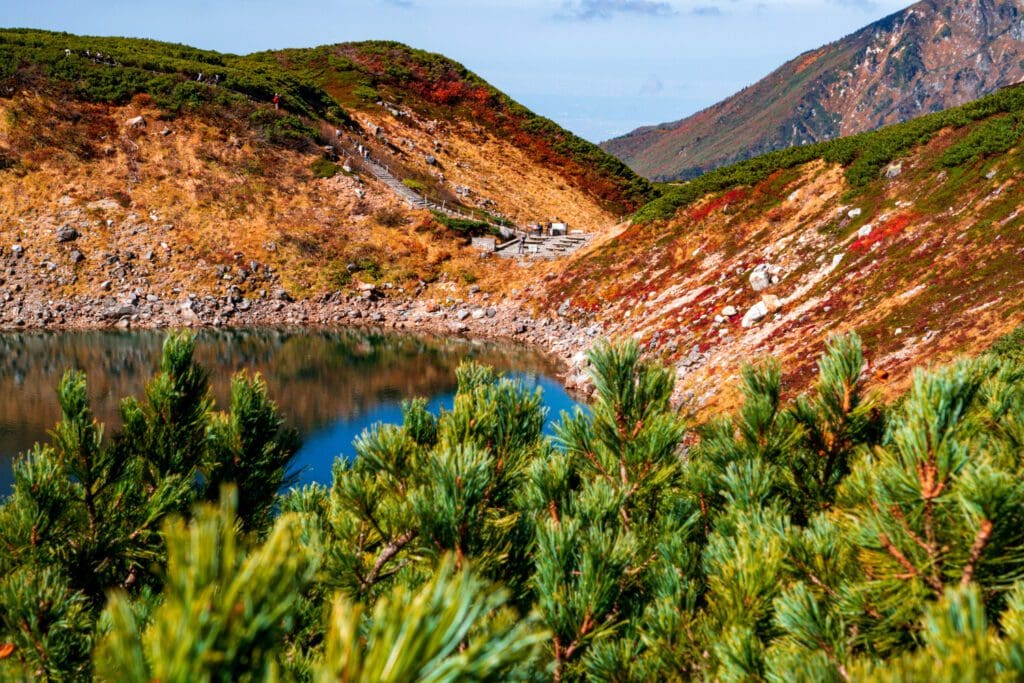
Mid-October is a good time to take the Tateyama Kurobe Alpine Route. Since part of the route is high elevation, this is one of the first places in Japan where the leaves change. For more precise timing, refer to tenki.jp, this site starts reporting foliage conditions in September.
How to Access:

Conveniently, there is an Alpine-Takayama-Matsumoto Area Tourist Pass that allows for unlimited travel from Nagoya to Toyama or Nagano. It also covers the entire cost of the various forms of transportation along the Alpine Route. The Alpine Route itself is very costly, so this pass is one of the most cost-effective train passes in the country.
To reach the Alpine Route from the Nagano side, start in Matsumoto, take a local or express train to Shinano-Ōmachi Station, and then take a bus to Ogizawa Station. There are also direct buses from Nagano Station to Ogizawa Station.
To reach the Alpine Route from the Toyama side, start at the Dentetsu-Toyama Station. Take the Toyama Chiho Railway to Tateyama Station.
Where to Stay:

A trip to Tateyama, one of the most sacred mountains in Japan, is at least an all-day activity. You can stay at Hotel Tateyama in Murodo, the highest-located hotel in the country. A more budget-friendly option would be to start from the Toyama side, spend the day hiking in Murodo, and then stay in Nagano City after taking the bus from Ogizawa.
2. Take in an Iconic View at Lake Kawaguchi
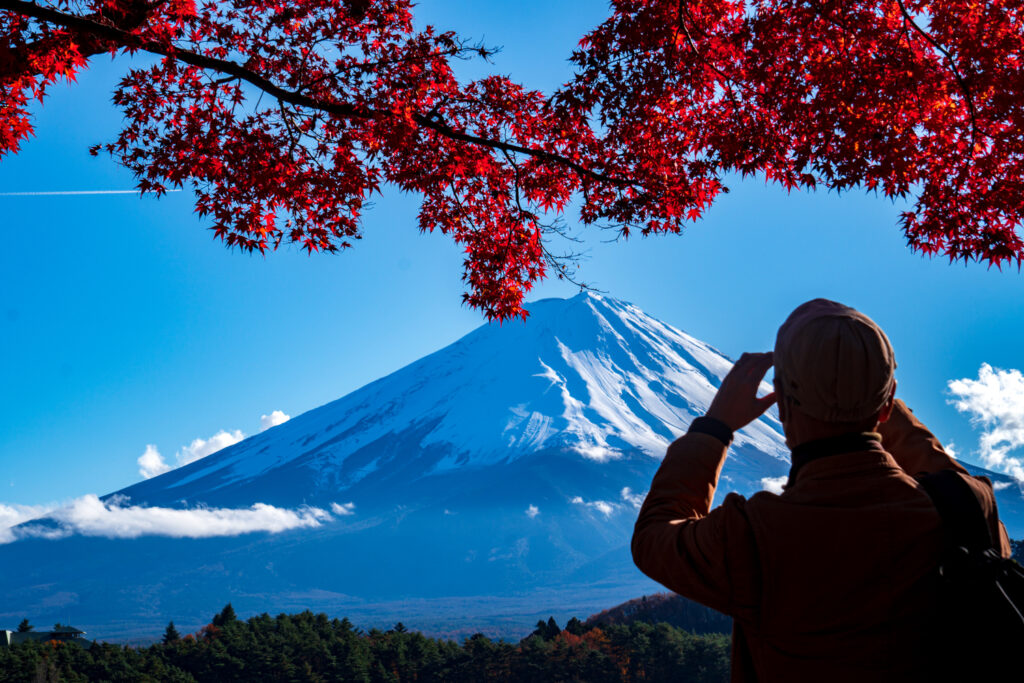
Lake Kawaguchi is one of the Five Fuji Lakes that formed from previous Mt. Fuji eruptions. Out of the five lakes, Kawaguchi remains the most “touristy.” You can visit the Yamanashi Gem Museum or take the Mt. Fuji Panoramic Ropeway.
However, if you visit when the fall colors in Japan dot the landscape, you should head to Momiji Tunnel, one of the most iconic Fuji photo spots. During autumn, you can photograph red leaves alongside Mt. Fuji.
When to Go:

Typically, the leaves at the Momiji Corridor reach peak color in mid-November. Japanguide.com frequently posts updates about the current conditions in the Fuji Five Lakes region. Before you head to Kawaguchi, check their forecast.
How to Access:
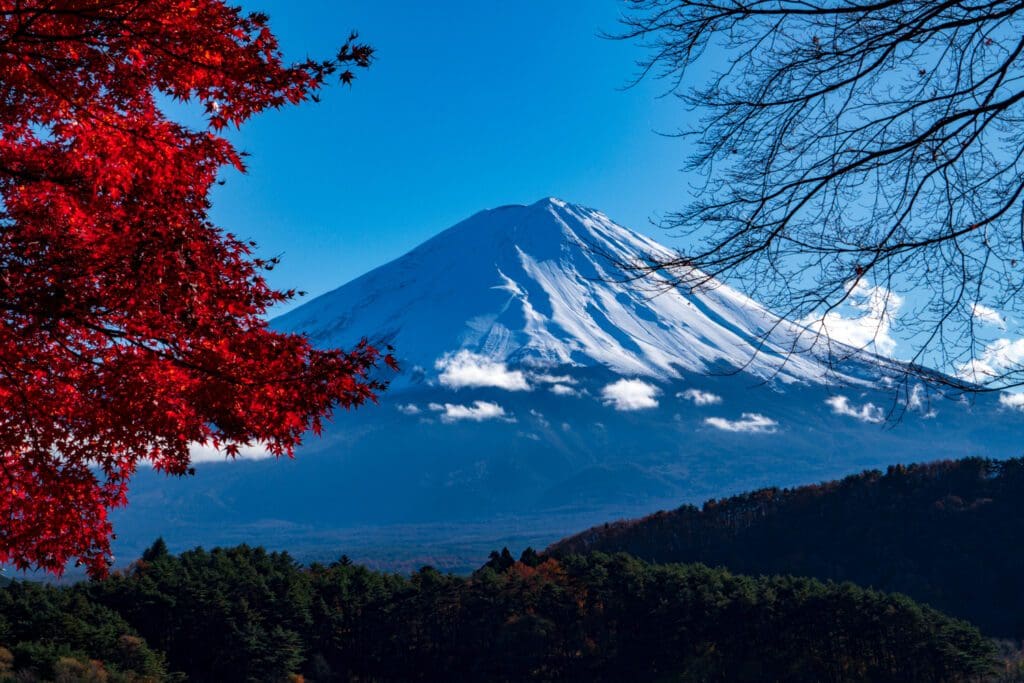
There are a few different ways to access Lake Kawaguchi. You can take a limited express JR train from Nagano to Kofu Station, covered by JR East Nagano Niigata Area Pass. From Kofu Station, you can take a bus to Lake Kawaguchi.
If you are coming from Tokyo, start at Shinjuku Station and take the JR Chuo Line to Otsuki Station. This trip is covered by the JR Pass. Then, transfer to the Fujikyu Line to Kawaguchiko Station, which is not covered by the pass. From Kawaguchiko Station, you can take a local bus to Lake Kawaguchi.
Where to Stay:
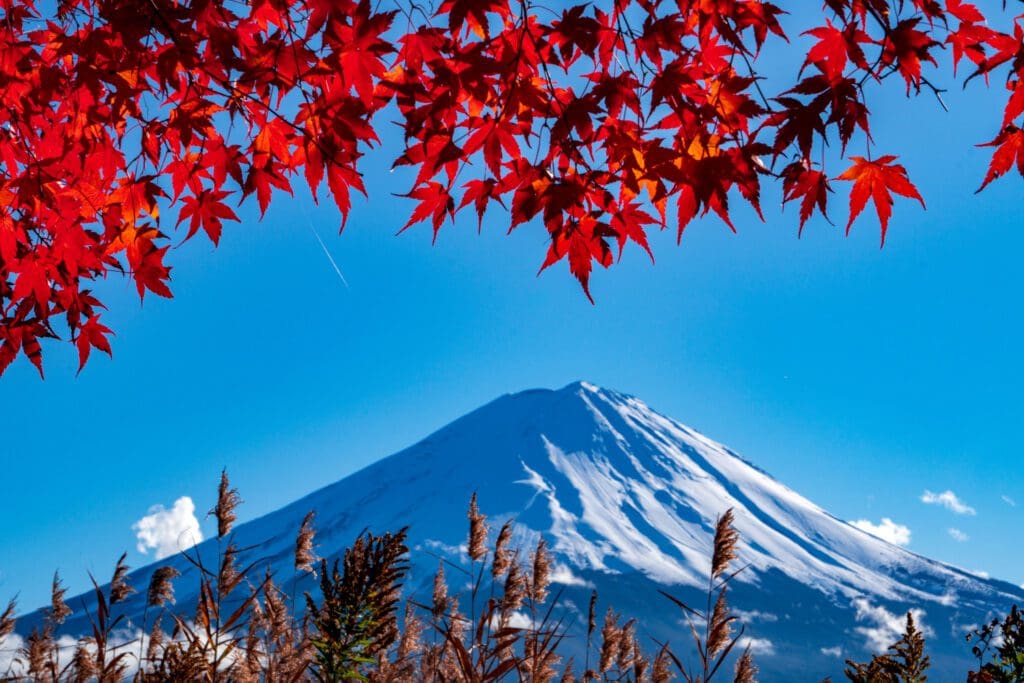
If visiting Lake Kawaguchi is on your Japan bucket list, staying at Dot Hostel is a no-brainer. Kawaguchi is a small area full of traditional Japanese inns that are stunning but so expensive.
However, even a budget traveler can stay overnight in this gorgeous area and wake up to views of Fuji, thanks to Dot Hostel. You can also rent a bike from the hostel for 1,000 yen. In less than 10 minutes, you can reach Momiji Tunnel.
3. Enjoy Falls Colors in Shiga Kogen, an Unspoiled Nature Park

Part of the Joshinetsu National Park, Shiga Kogen is one of the premiere spots to hike and enjoy fall colors in Japan. Shiga Kogen is a few minutes up the mountain from Snow Monkey Park, one of Nagano’s most famous tourist destinations.
The park is spacious and has varied elevations, meaning there are multiple areas to enjoy fall colors. One of my favorite places in the park is the Biwa Pond, which is a short walk from Hasu Pond, the main bus stop in Shiga Kogen.
If you want a longer hike, visit Ohnuma Pond. You can start at Onumaike Iriguchi bus stop, and after walking 2 miles down a service road, you will reach the pond. This volcanic lake reflects an unforgettable deep blue hue.
Due to the vital ecosystem in the park, it was declared a UNESCO Biosphere Conservation Area in 1981.
When to Go:

Since Shiga Kogen is home to high mountain peaks and low marshes, you can see fall colors from early October and into November in different areas of the park. To see when Biwa Pond is at peak color, refer to tenki.jp. This site starts reporting foliage conditions in September.
How to Access:
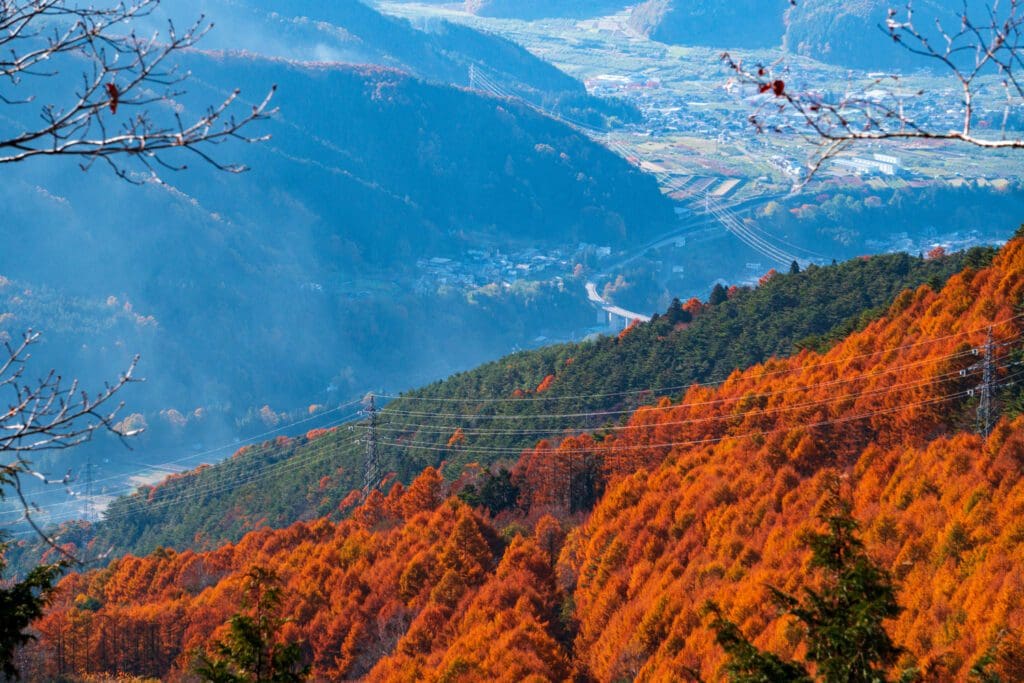
The easiest way to access Shiga Kogen is by taking a bus from Nagano Station’s East Exit. You will pay for the bus ticket once you board the bus. A one-way ticket costs 2,200 yen, and the trip takes about an hour.
The bus from Nagano Station ends at the Hasu Pond. If you want to go further up the mountain, you must transfer to another bus. However, most visitors disembark at the pond and hike around Hasu and Biwa Pond.
Where to Stay:
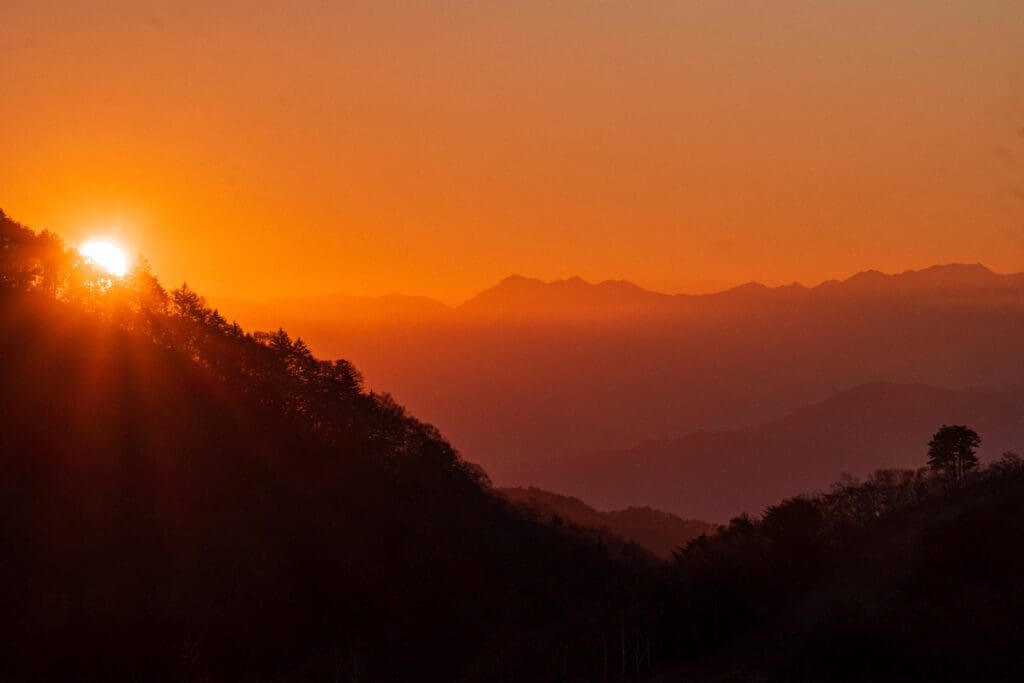
You can stay in Shiga Kogen, but the highland has few budget accommodations. Since Nagano Station is only an hour away, I recommend staying in Nagano City when you visit Shiga Kogen.
Stay at Worldtreck Dinner & Guesthouse Pise in Nagano City because it is in a central area near Zenkoji Temple.
4. Get Lost in Autumn’s Beauty in Togakushi
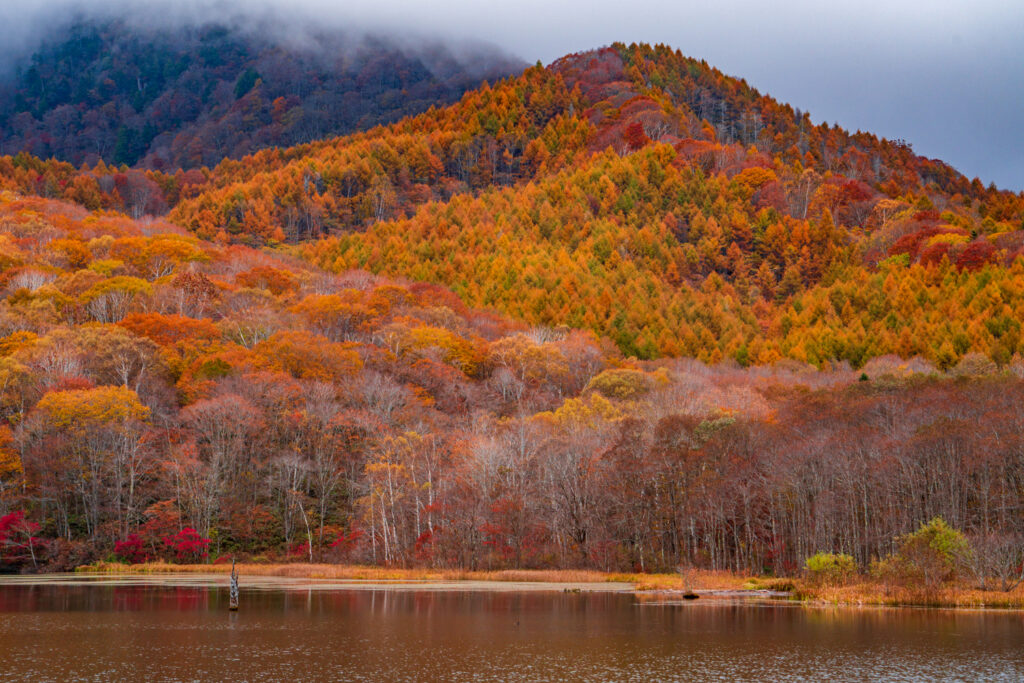
Like Shiga Kogen, Togakushi is another highland only an hour away from Nagano City. Known to the Japanese as a “power spot” where Gods dwell, this highland is home to a national park, a campground, a ski resort, and a 5-shrine pilgrimage hike.
It is one of the best spots to see fall colors in Japan in autumn. From the Kagami Pond, a scenic spot known for reflecting the mountains on its waters, to the summit of Mt. Takamatsu, you could spend days taking in the fall foliage in Togakushi.
When to Go:
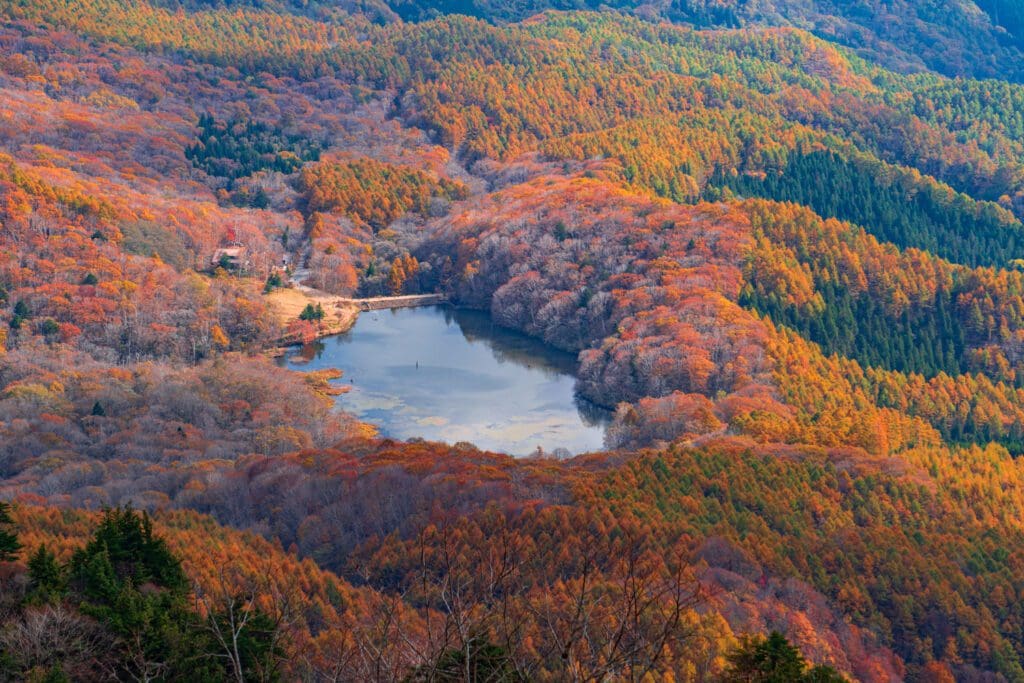
Since Togakushi is a highland, the leaves change colors in early fall. Mid-October is typically when you will see the most red and orange trees. For more precise timing, refer to tenki.jp. This site starts reporting foliage conditions in September.
How to Access:
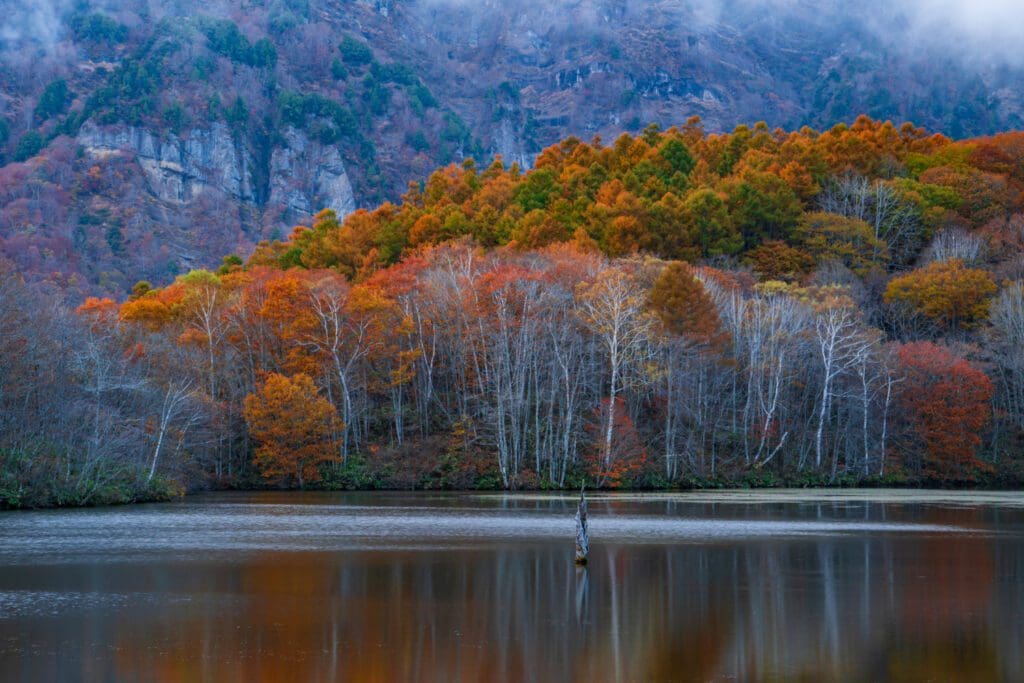
Nagano can be easily accessed from Kanazawa or Tokyo. Take the Hokuriku Shinkansen to reach Nagano Station. If you are taking other trips around Nagano to Hakuba or Snow Monkey Park, purchase the JR East Nagano Niigata Area Pass.
Exit Nagano Station by using the Zenkoji Exiting and buy your bus ticket to Togakushi at the Alpico Bus Ticket Office (1,350 yen one-way). Directly outside of the ticketing office is bus stop 7, where you can board the bus to Togakushi.
Where to Stay:
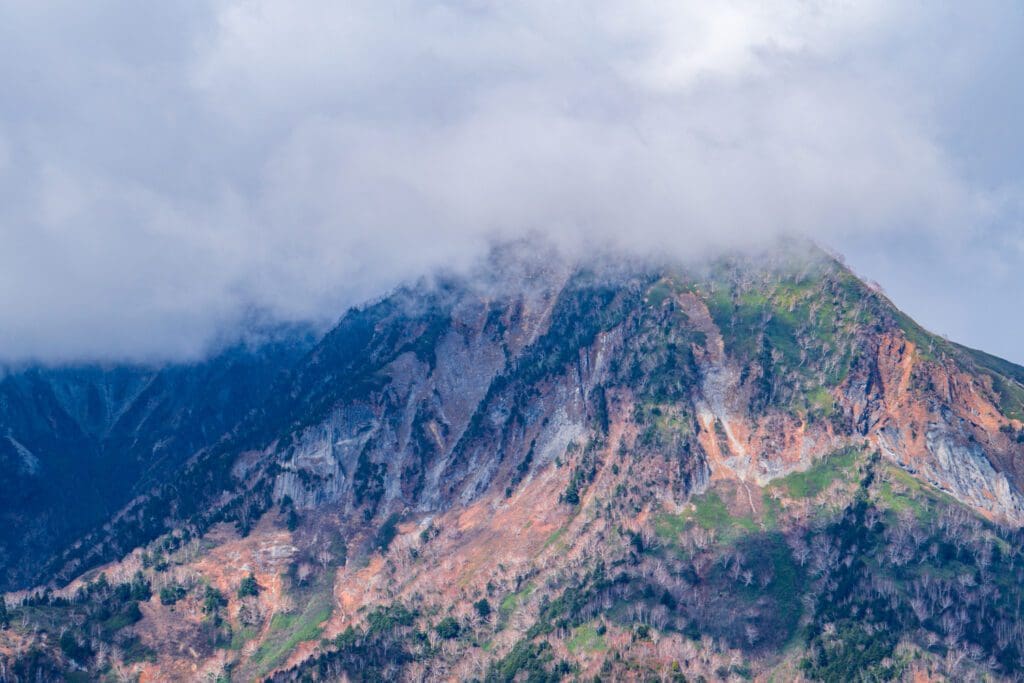
If you visit in the summer or early fall, you can tent camp at Togakushi for 3,000 yen. It is one of the largest campgrounds in the country and has plenty of amenities like a camp store and shower.
If you are visiting during colder months, it is very convenient to stay in Nagano City. Nagano City is only an hour’s bus ride away. Stay at Worldtreck Dinner & Guesthouse Pise in Nagano City because it is in a central area near Zenkoji Temple.
5. See Fall Colors Without Hiking at the Nagano Olympic Stadium
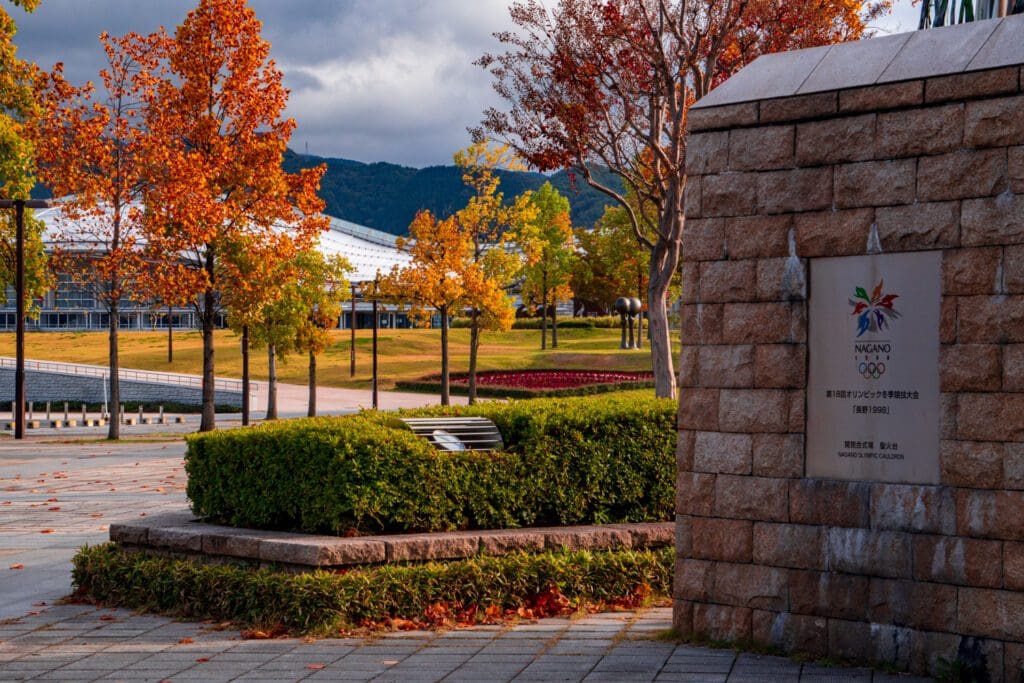
Another great spot to see fall colors in Japan is at the Nagano Olympic Stadium. It might not be the first place you think of when scouting fall foliage. However, if you visit Shiga Kogen or Togakushi during the fall, you should also stop by the Nagano Olympic Stadium.
The Olympic Stadium hosted the opening and closing ceremonies of the 1998 Olympic Games. The park’s historic venues are surrounded by bright orange trees in autumn. The sports park becomes one of the most popular places to see fall colors in Nagano City.
When to Go:
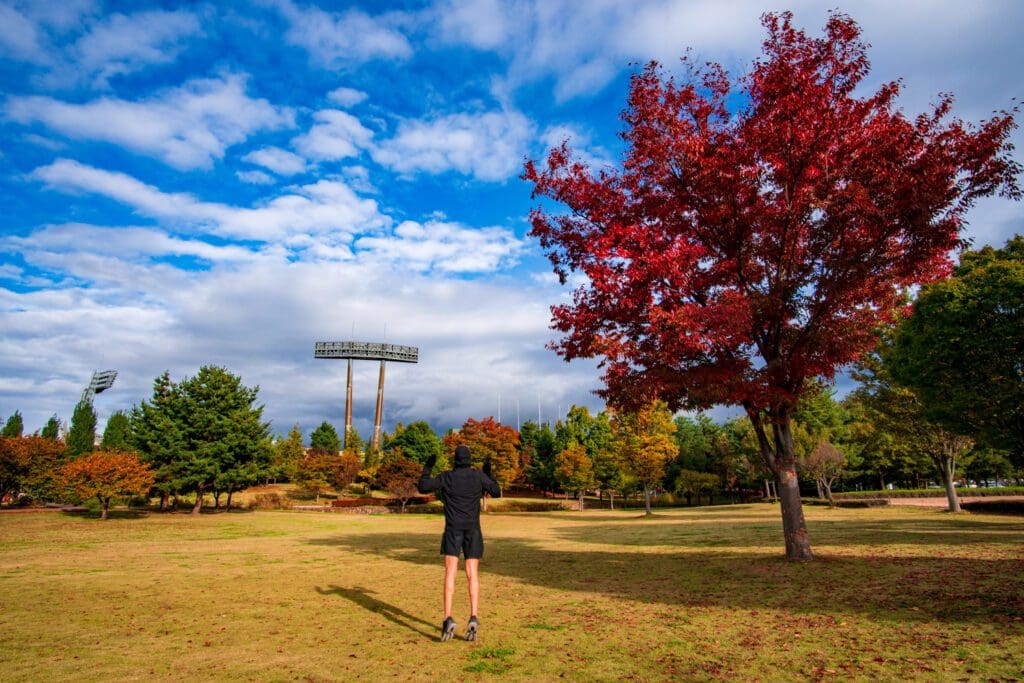
Early November is typically when fall colors reach their peak in Nagano City.
How to Access:
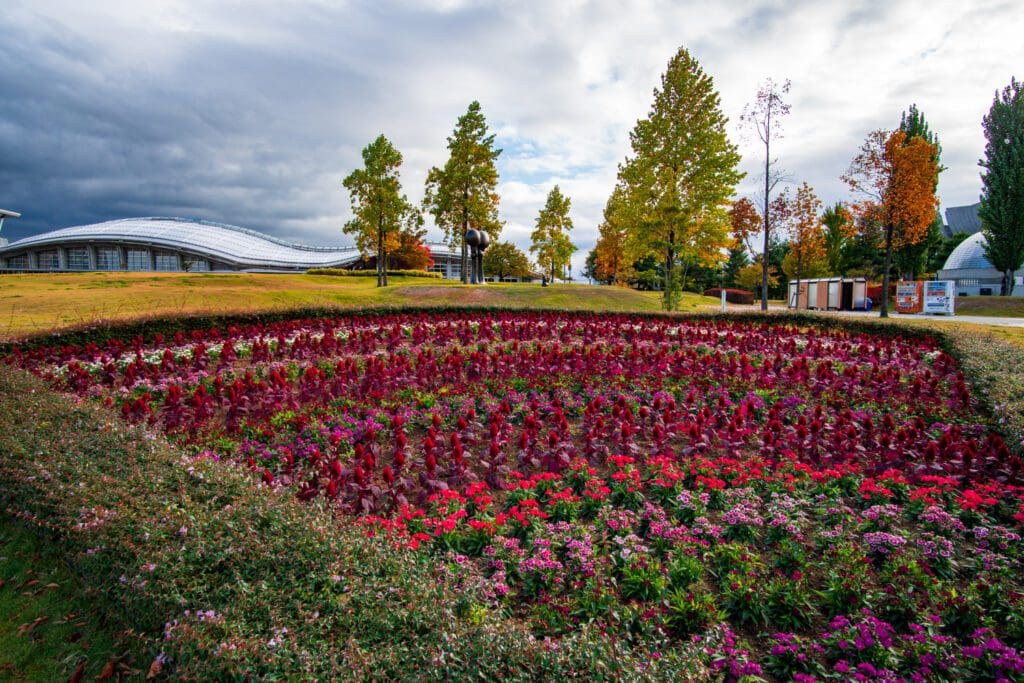
The cheapest way to access the Nagano Olympic Stadium is by taking the Shinonoi Line to Shinonoi Station from Nagano Station for 200 yen. Then, walking 1.5 miles to the stadium. You can also take a bus from Shinonoi Station to reach the stadium.
Where to Stay:
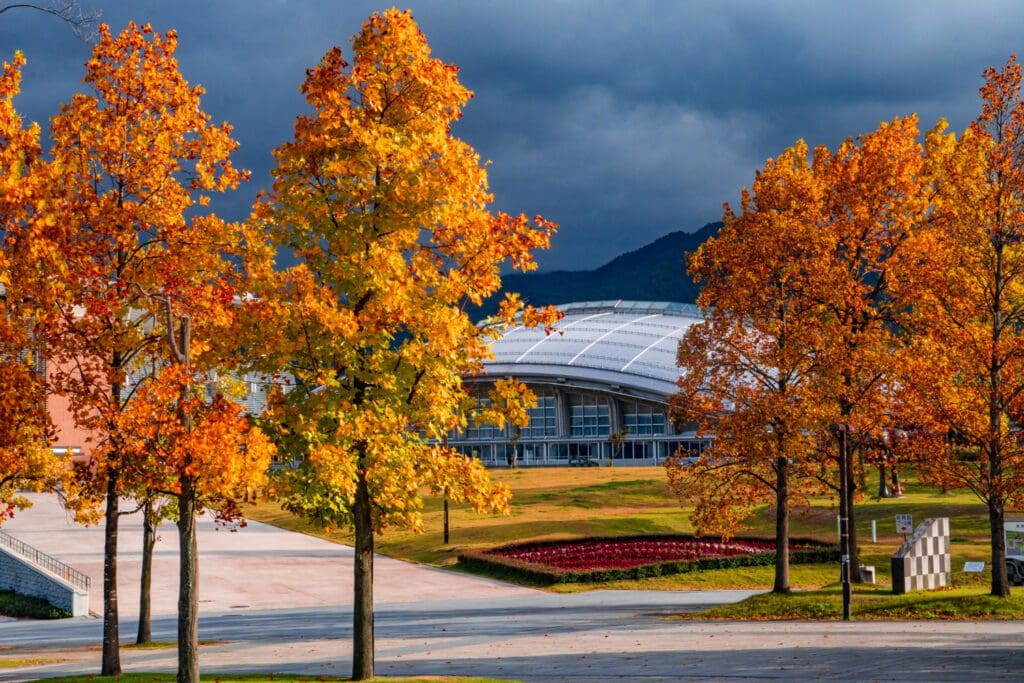
Stay at Worldtreck Dinner & Guesthouse Pise in Nagano City because it is in a central area near Zenkoji Temple.
6. Take in an Epic Fall View at the Arato Castle Ruins
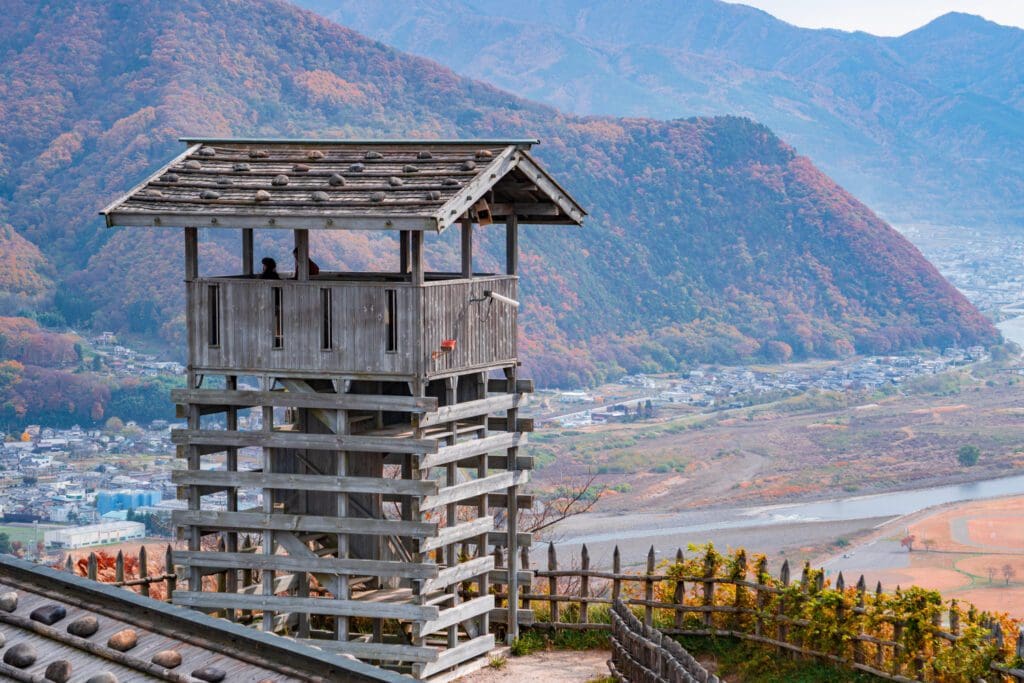
30 minutes south of Nagano City is Togura. This small onsen city is known for its hot springs and traditional Japanese inns. Besides bathing in the healing sulfuric waters, you can visit the Arato Castle Ruins.
This mountain fortress dates back to 1467, when castles were built for defense. Now, for 300 yen, you can tour this reconstructed castle that overlooks Togura. During autumn, these ruins become a great spot to see fall colors in Japan without large crowds.
When to Go:
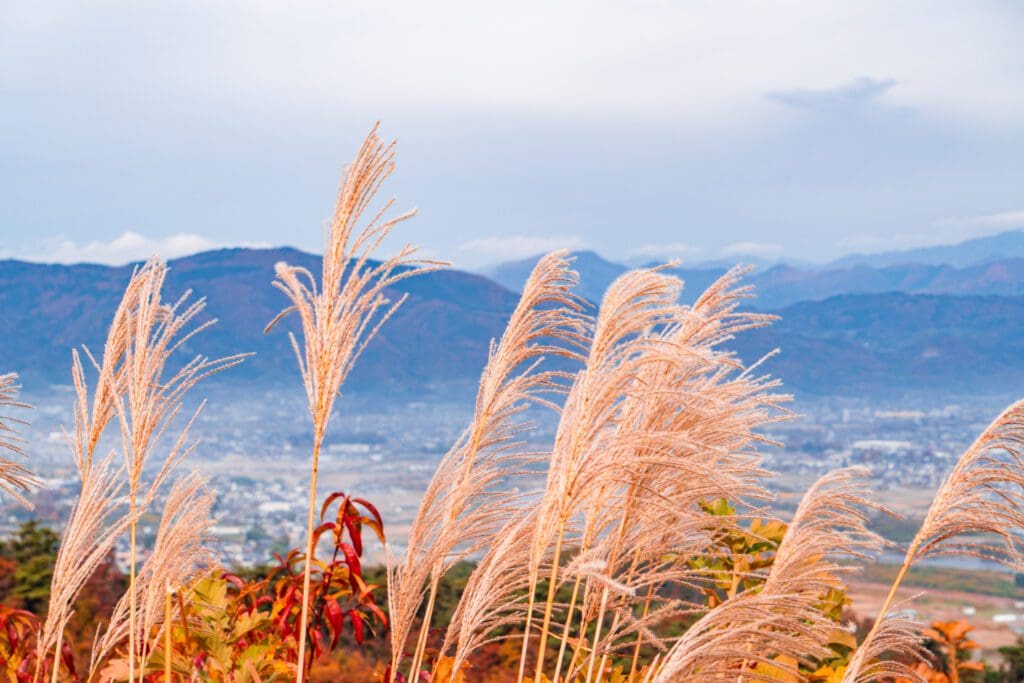
Early November is typically the best time to see the fall foliage on top of the Arato Castle Ruins.
How to Access:

From Nagano Station, take the JR Shinonoi Line to Shinonoi Station from Nagano Station to Togura Station for 460 yen. A few buses run from Togura Station and can get you closer to the castle ruins, but no buses directly run to the ruins.
Unless you are willing to call a taxi, you must walk 2.5 miles up to the castle ruins. Although it is a long walk, it is a beautiful stroll. You will pass the Chikuma River and many traditional onsens.
Where to Stay:

You can stay at a Kamesei Ryokan, a traditional Japanese inn owned by Tyler Lynch, an American who wants to make the town more accessible to foreign tourists than other onsen towns.
7. Photograph a Sea of Yellow at Ueda Castle
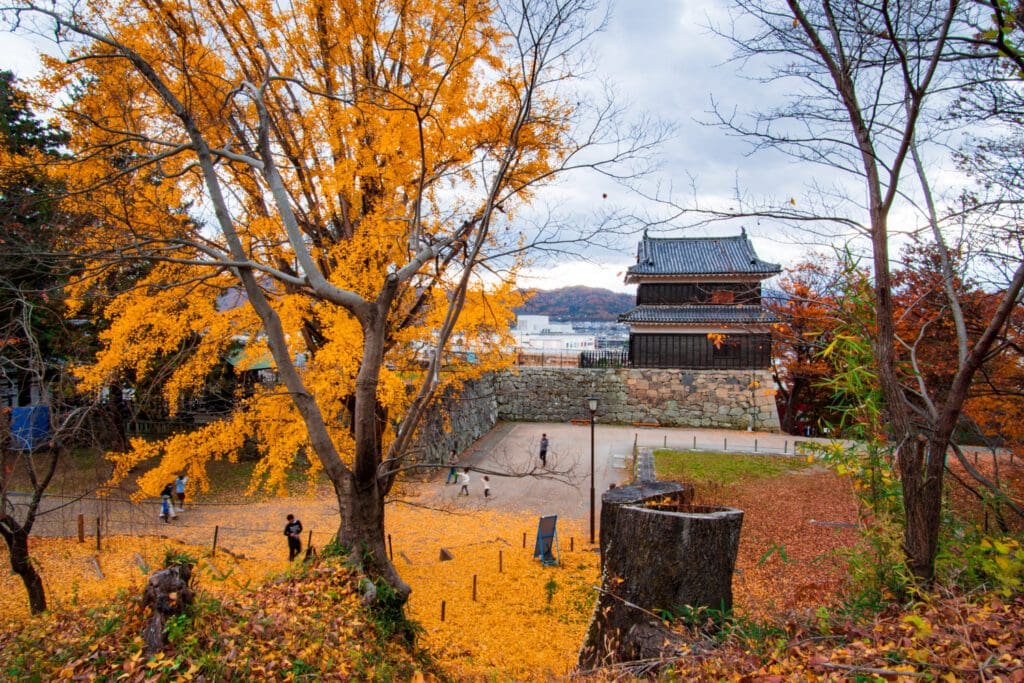
If you continue on the Shinonoi Line towards Karuizawa from Togura, you will reach Ueda. Ueda is a large city like Nagano City, but it is less famous. However, it is worth a visit during autumn because of its large castle park.
In November, the castle park hosts a fall festival and sees many visitors. It is one of the best places to see fall colors in Nagano. You will find many stunning areas to photograph from moats to shrines here.
When to Go:
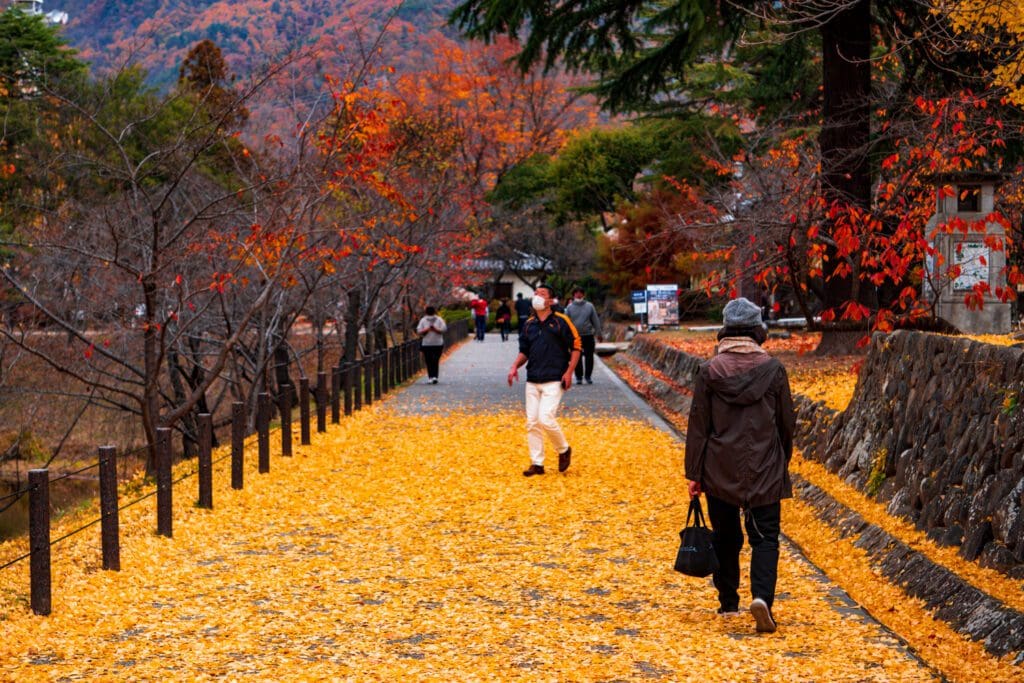
From early to mid-November, you can usually enjoy abundant yellow Ginkgo trees around Ueda Castle Park.
How to Access:

You can reach Ueda from Nagano Station by the local Shinonoi Line or the Hokuriku Shinkansen. Although a trip to Ueda on the Shinkansen takes 24 minutes (the local train takes 54 minutes), taking the local Shinonoi Line to Ueda is much more cost-effective.
Once you reach Ueda Station, it is a 12-minute walk to the castle park.
Where to Stay:
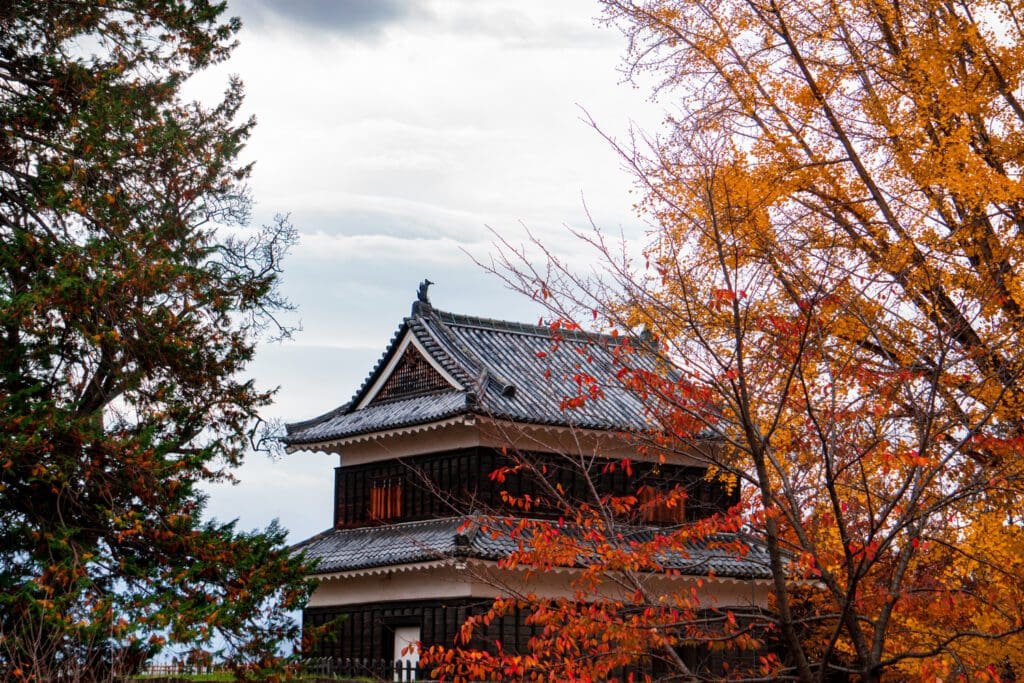
Since Ueda is close to Nagano City, I recommend staying at Worldtreck Dinner & Guesthouse Pise in Nagano City. This budget hostel is a great place to stay when visiting Nagano.
8. Enjoy Fall Colors in Karuizawa, an Upscale Resort Town

Karuizawa is a resort town that sits on the border between Nagano and Gunma Prefectures. On the weekends, visitors flock here from Tokyo to enjoy Karuizawa’s charming shopping streets and high-end designer outlets.
If you visit Karuizawa during the fall, you will have many options for spots to see incredible fall colors in Japan. You can hike or take a bus to the Usui Pass, an observation platform with views of Mt. Asama (an active volcano).
You can also rent a bike near Karuizawa Station and bike to Kumoba Pond, another famous spot to see fall colors in Japan. Karuizawa is undoubtedly one of the best towns to visit during the fall.
When to Go:
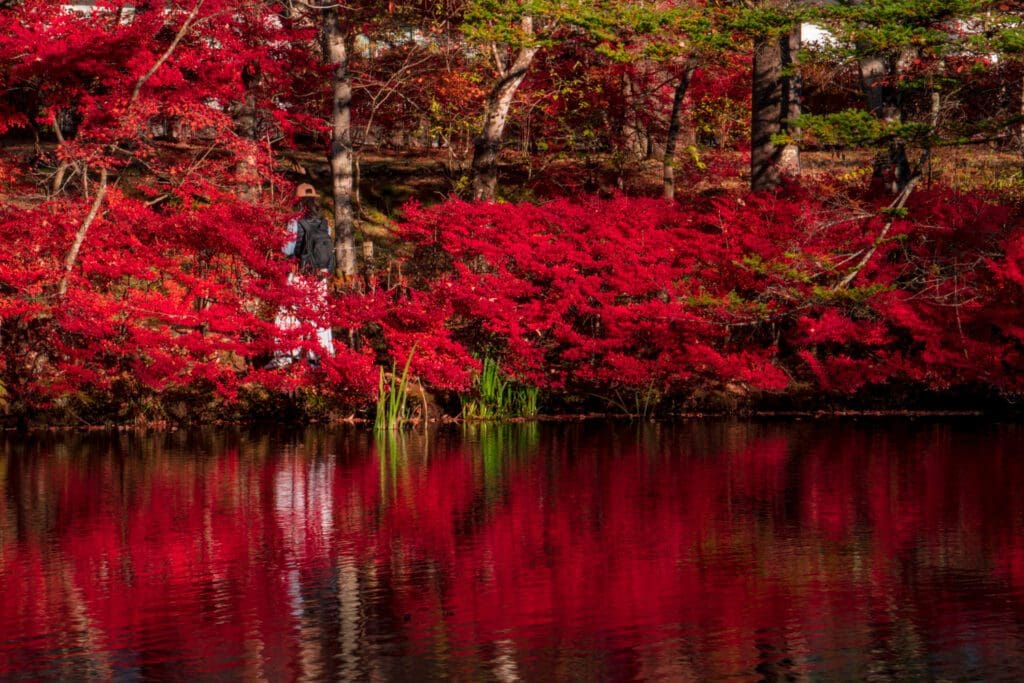
The end of October is usually the best time to see peak fall foliage. Tenki.jp.com reports on current conditions at the Usui Pass.
How to Access:
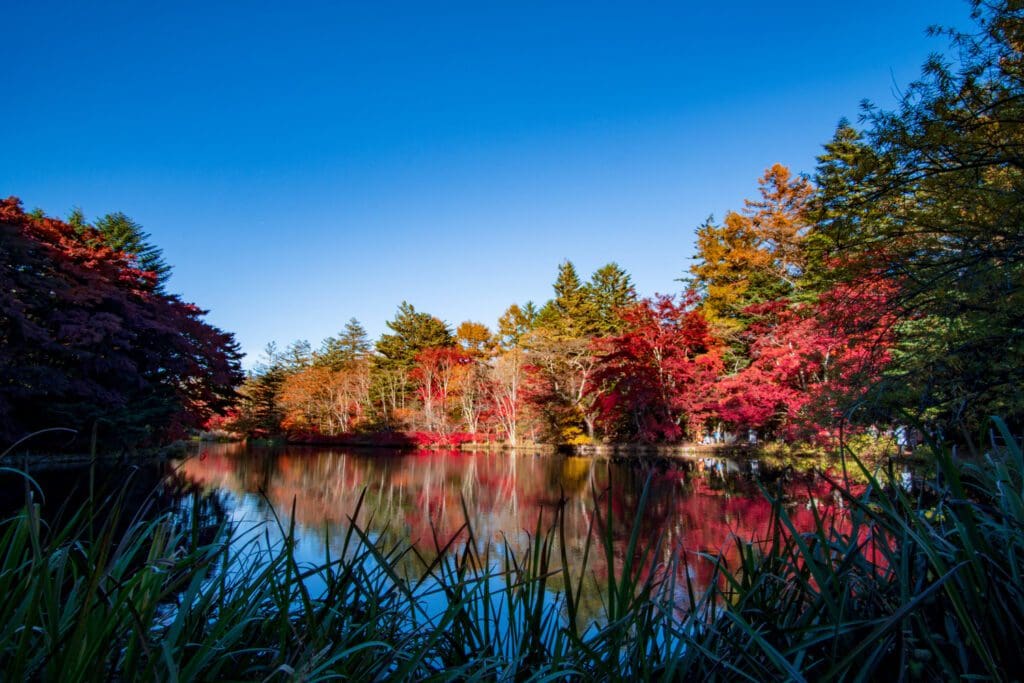
You can reach Karuizawa from Tokyo in about 2 ½ hours since Karuizawa is a stop on the Hokuriku Shinkansen. You can also take the Hokuriku Shinkansen from Nagano to Karuizawa, which only takes about an hour. However, you can save over 1,500 yen if you take the local Shinonoi Line, but it will double your travel time.
Where to Stay:
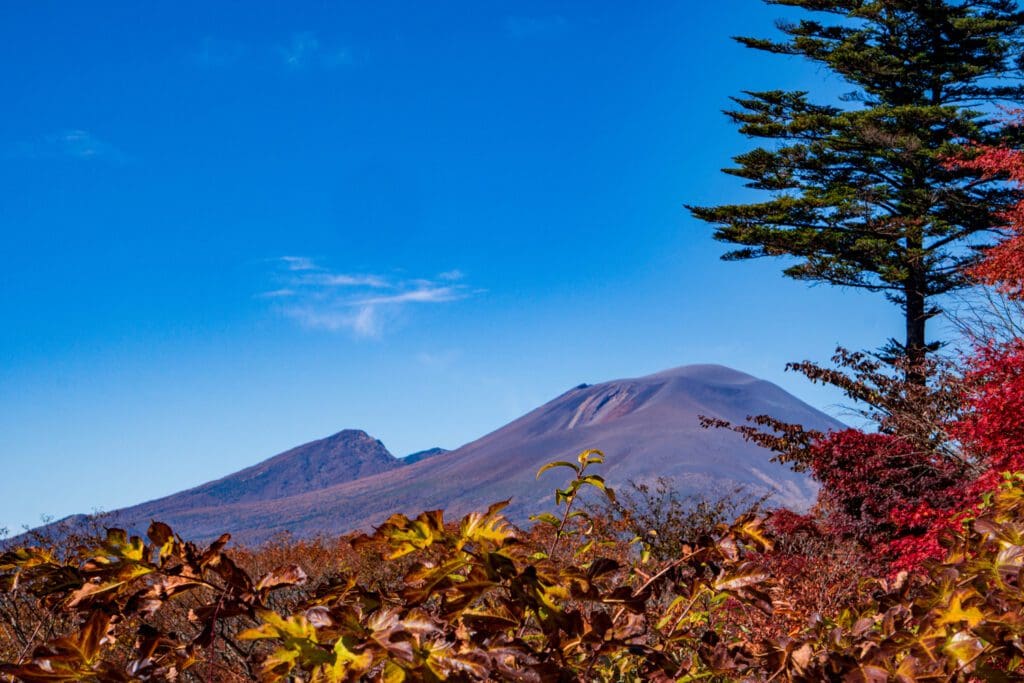
Karuizawa is a resort town with few budget accommodations. I recommend staying in Tokyo or Nagano City and taking a day trip to Karuizawa if you are on a budget.
9. Take the Train From Tokyo to Okutama

If you visit Japan during the fall but do not have much time to see fall colors, you should take a day trip to Okutama. You can reach this mountainous wonderland from central Tokyo in less than two hours.
Okutama is the JR Ome Line’s final stop and the gateway into the Chichibu-Tama-Kai National Park, a popular hiking destination for Tokyo locals. One of the most popular activities is taking the cable car to Mount Mitake.
If you visit Okutama during the fall, you cannot miss taking the bus to Lake Okutama. You can see some breathtaking fall colors here.
When to Go:
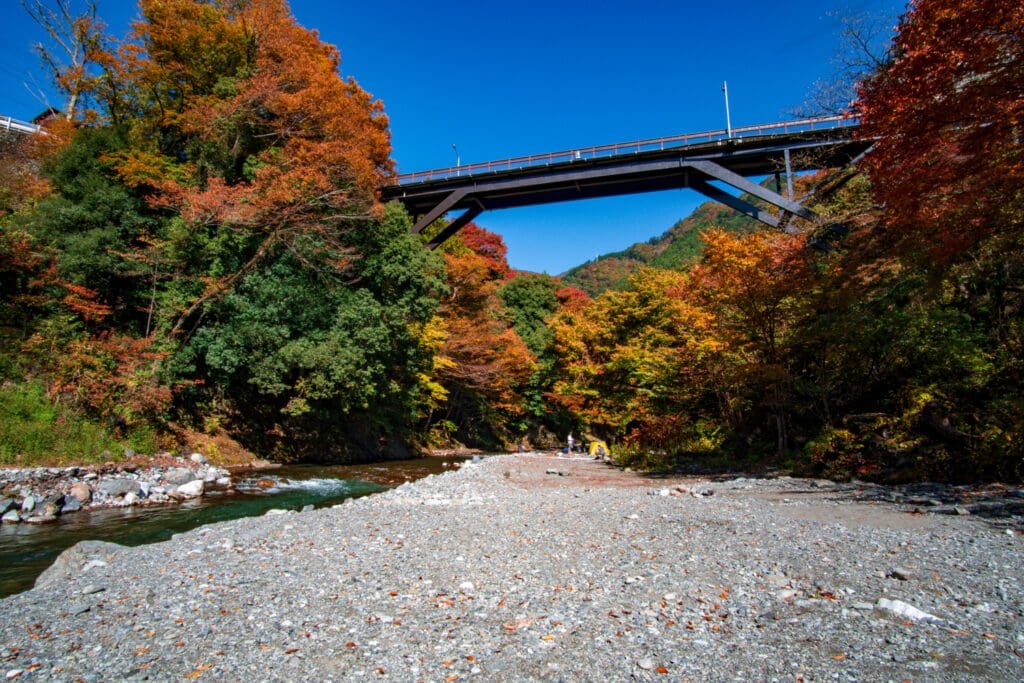
Typically, mid-November is a good time to catch plenty of red and yellow leaves in Okutama.
How to Access:
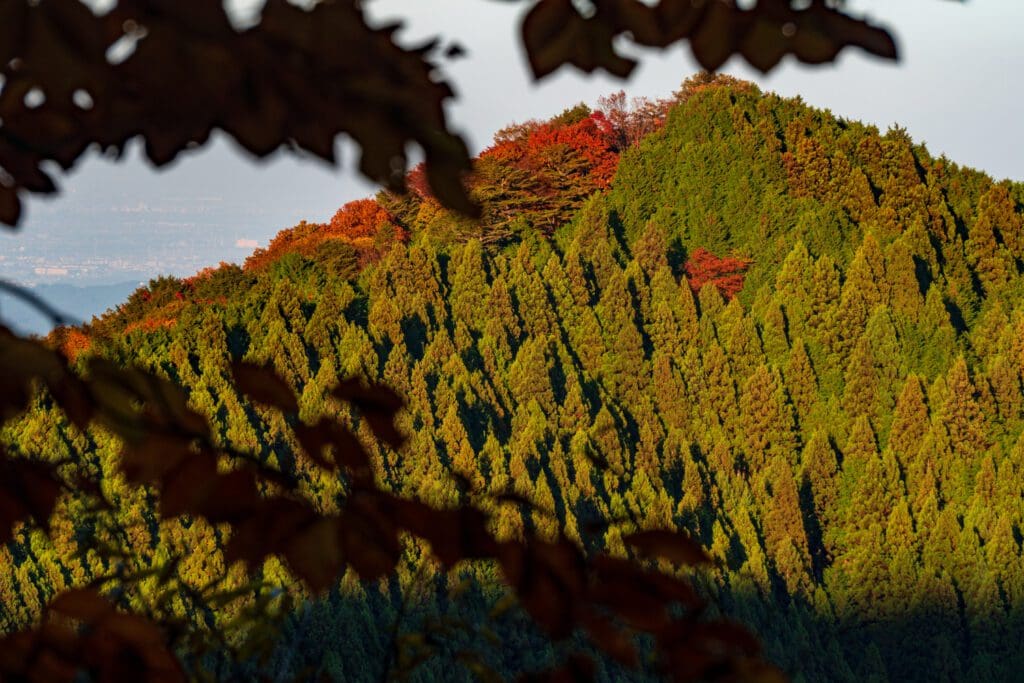
From Central Tokyo, take the local Chuo Line to Ome Station. At Ome Station, transfer to the local Ome Line to Oku-Tama Station.
Where to Stay:
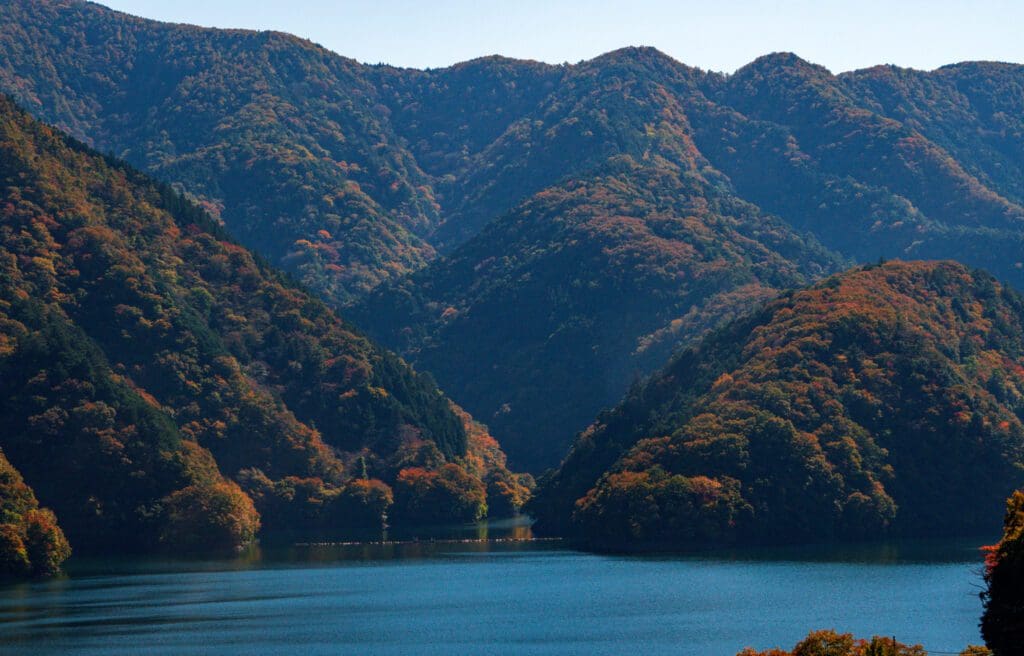
You can stay anywhere in Tokyo for easy access to Okutama. My favorite district to stay in the city is Shinjuku. Shinjuku has great nightlife like Shibuya but also has calm resting spots like the Shinjuku Southern Terrace and Shinjuku Gyoen National Garden.
10. Go to Daisetsuzan, Where Autumn Colors First Appear in Japan
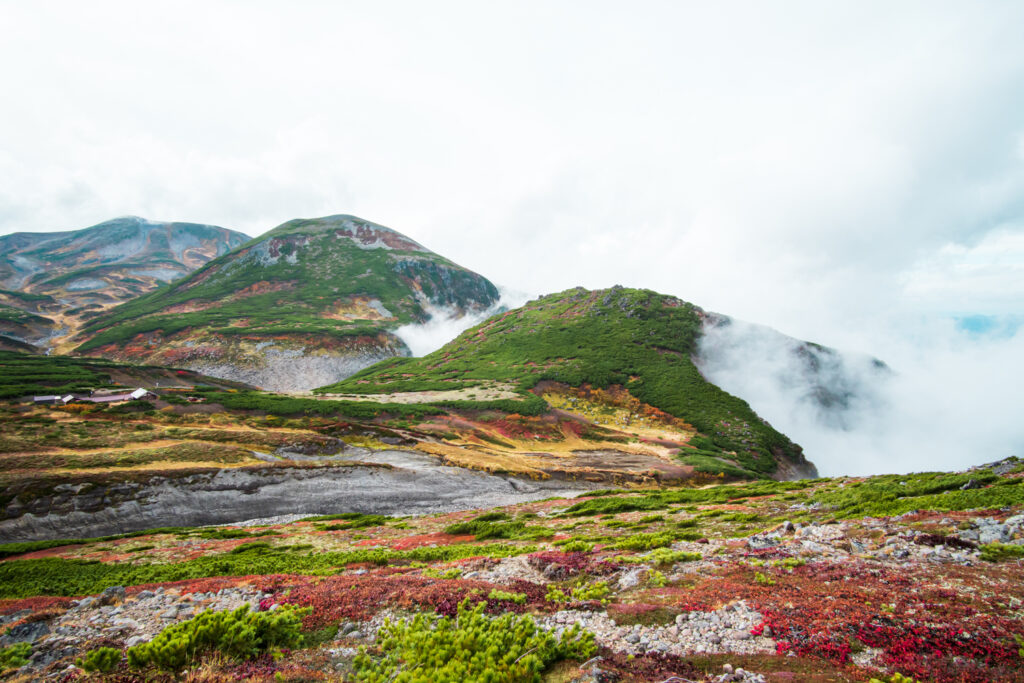
Daisetsuzan National Park is Hokkaido’s largest national park. It is also the first spot you can see fall colors in all of Japan due to the park’s high elevation.
Hokkaido is the largest of Japan’s four main islands and is home to some of my favorite national parks worldwide. If you want to visit Daisetsuzan National Park but only have a few days to do so, I recommend going to Mount Kurodake.
It is not necessarily the most famous mountain in the park, but one of the most accessible. From Sounkyo Onsen, you can take the Kurodake Ropeway up to the 5th Station. Then, you can take a chairlift to the 7th Station of Kurodake. Here, you can begin a steep, hour-long hike to the interior of the Daisetsuzan mountains.
The views on top of Kurodake are unmatched during fall. If you have extra time, you can hike from Kurodake to Asahidake, the more famous mountain in the park.
When to Go:
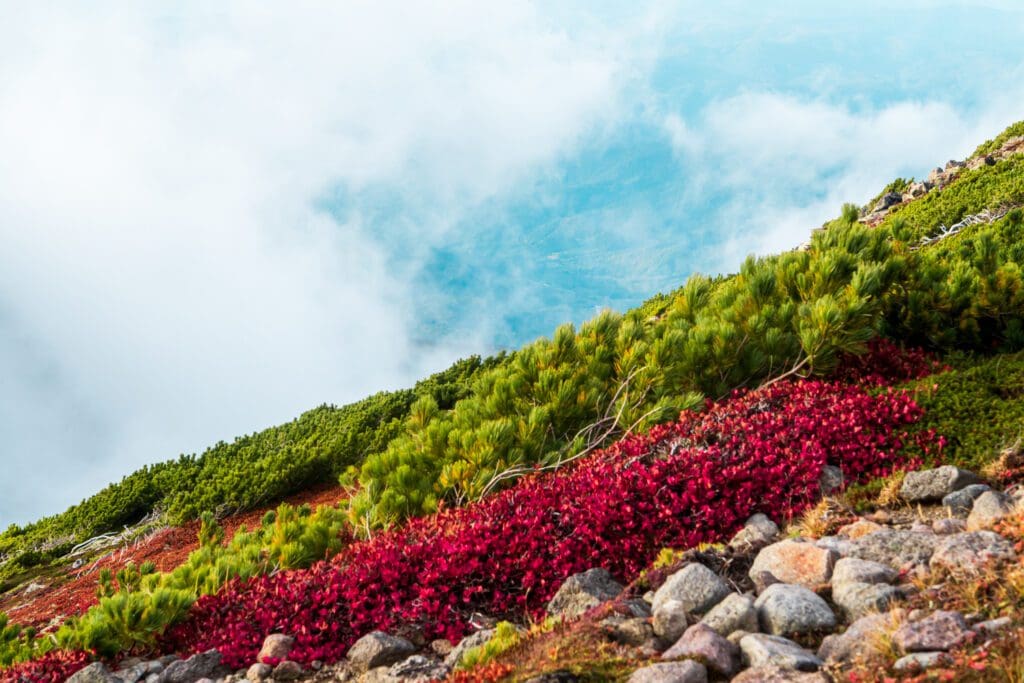
Autumn colors tend to appear on Mount Kurodake as early as the beginning of September. However, you might find the most vivid colors towards the end of September.
How to Access:
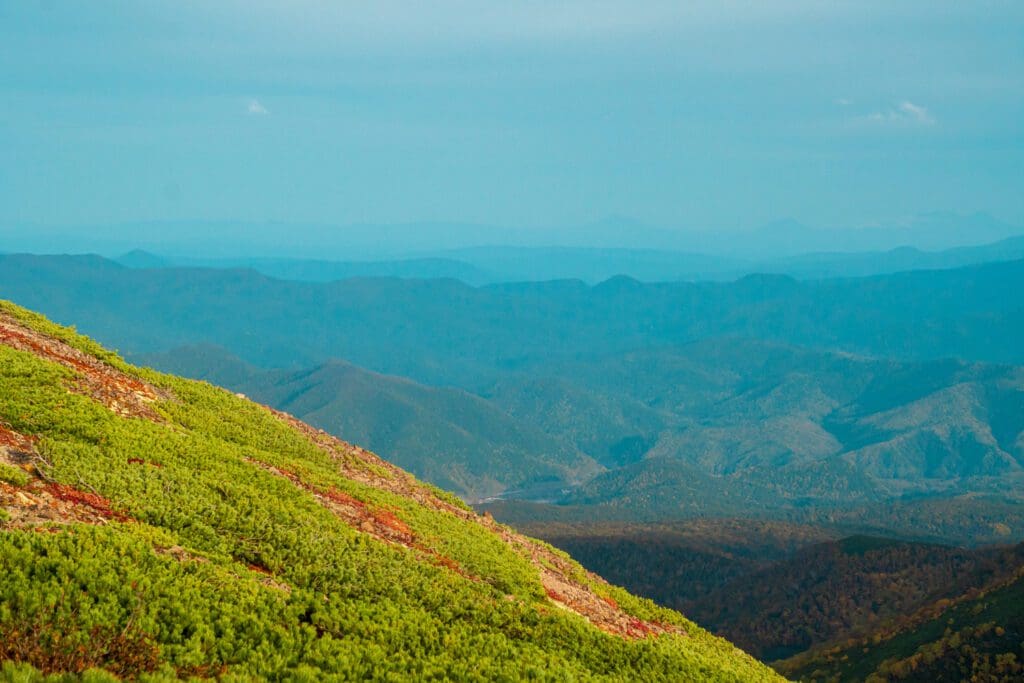
There are direct buses between Asahikawa Station and Sounkyo Onsen for around 2,000 yen. Buses also run from Lake Akan to Sounkyo Onsen.
Where to Stay:
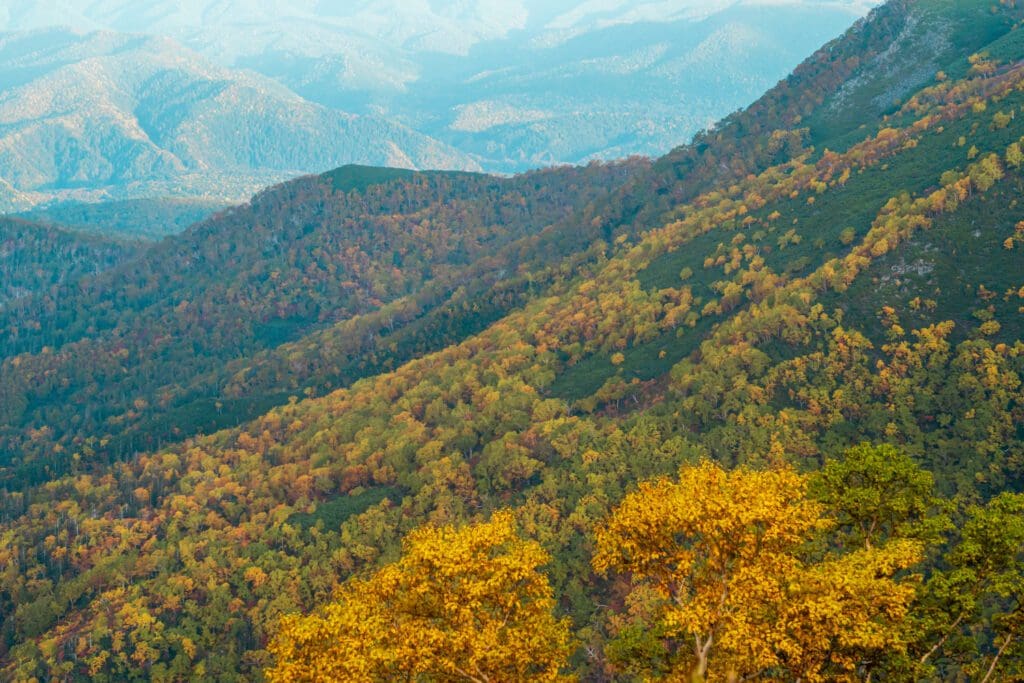
Asahikawa is Hokkaido’s second-largest city and the closest major city to Sounkyo Onsen. The city has plenty of places to stay on a budget.